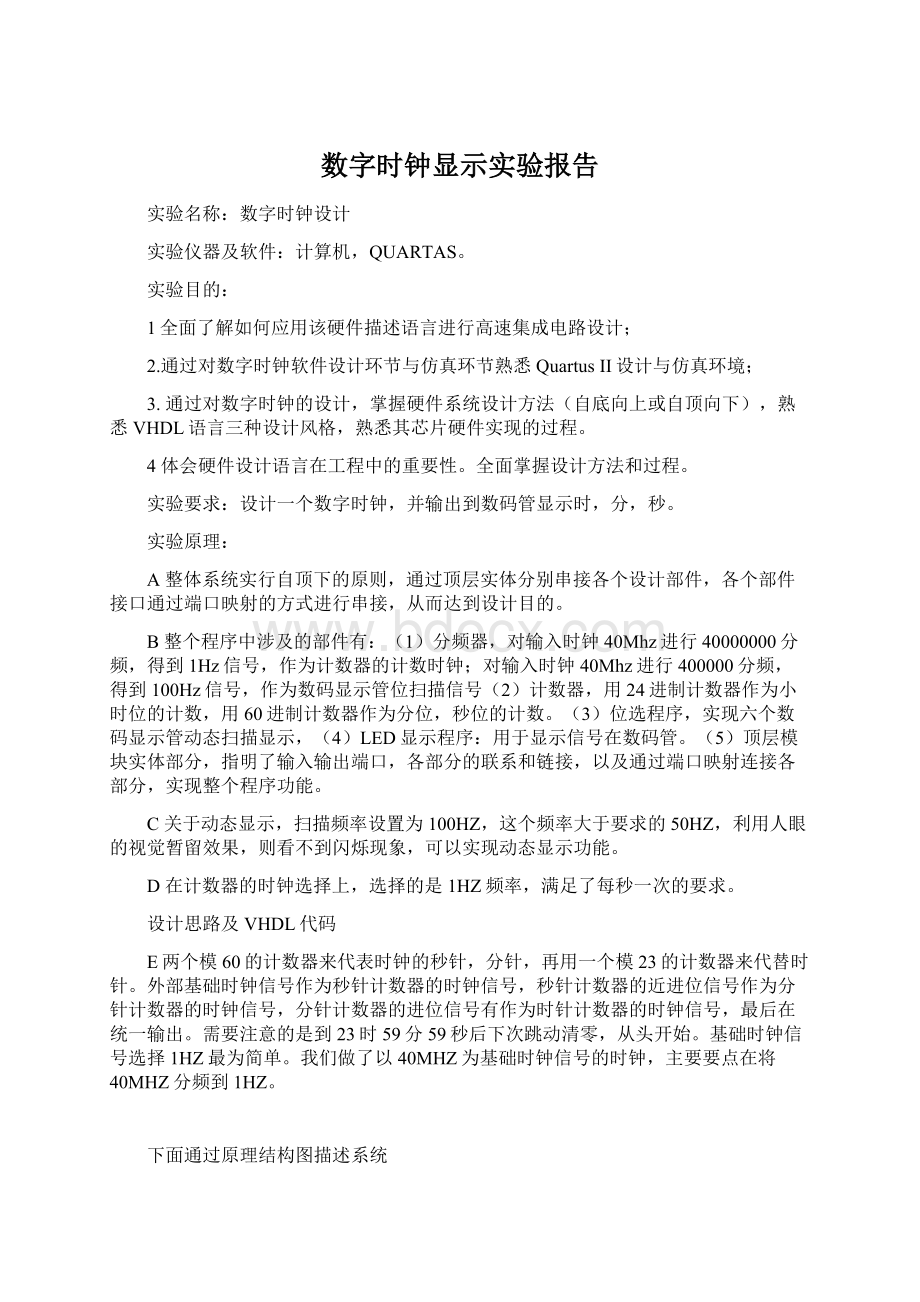数字时钟显示实验报告.docx
《数字时钟显示实验报告.docx》由会员分享,可在线阅读,更多相关《数字时钟显示实验报告.docx(23页珍藏版)》请在冰豆网上搜索。

数字时钟显示实验报告
实验名称:
数字时钟设计
实验仪器及软件:
计算机,QUARTAS。
实验目的:
1全面了解如何应用该硬件描述语言进行高速集成电路设计;
2.通过对数字时钟软件设计环节与仿真环节熟悉QuartusII设计与仿真环境;
3.通过对数字时钟的设计,掌握硬件系统设计方法(自底向上或自顶向下),熟悉VHDL语言三种设计风格,熟悉其芯片硬件实现的过程。
4体会硬件设计语言在工程中的重要性。
全面掌握设计方法和过程。
实验要求:
设计一个数字时钟,并输出到数码管显示时,分,秒。
实验原理:
A整体系统实行自顶下的原则,通过顶层实体分别串接各个设计部件,各个部件接口通过端口映射的方式进行串接,从而达到设计目的。
B整个程序中涉及的部件有:
(1)分频器,对输入时钟40Mhz进行40000000分频,得到1Hz信号,作为计数器的计数时钟;对输入时钟40Mhz进行400000分频,得到100Hz信号,作为数码显示管位扫描信号
(2)计数器,用24进制计数器作为小时位的计数,用60进制计数器作为分位,秒位的计数。
(3)位选程序,实现六个数码显示管动态扫描显示,(4)LED显示程序:
用于显示信号在数码管。
(5)顶层模块实体部分,指明了输入输出端口,各部分的联系和链接,以及通过端口映射连接各部分,实现整个程序功能。
C关于动态显示,扫描频率设置为100HZ,这个频率大于要求的50HZ,利用人眼的视觉暂留效果,则看不到闪烁现象,可以实现动态显示功能。
D在计数器的时钟选择上,选择的是1HZ频率,满足了每秒一次的要求。
设计思路及VHDL代码
E两个模60的计数器来代表时钟的秒针,分针,再用一个模23的计数器来代替时针。
外部基础时钟信号作为秒针计数器的时钟信号,秒针计数器的近进位信号作为分针计数器的时钟信号,分针计数器的进位信号有作为时针计数器的时钟信号,最后在统一输出。
需要注意的是到23时59分59秒后下次跳动清零,从头开始。
基础时钟信号选择1HZ最为简单。
我们做了以40MHZ为基础时钟信号的时钟,主要要点在将40MHZ分频到1HZ。
下面通过原理结构图描述系统
一,顶层实体模块源代码
数字钟的顶层模块程序clock.vhd
libraryieee;
useieee.std_logic_1164.all;
useieee.std_logic_unsigned.all;
useieee.std_logic_arith.all;
entityclockis
port(clk:
instd_logic;
set:
instd_logic;
qin_s_1:
instd_logic_vector(3downto0);--秒钟的低位调整输入端
qin_s_2:
instd_logic_vector(3downto0);--秒钟的高位调整输入端
qin_m_1:
instd_logic_vector(3downto0);--分钟的低位调整输入端
qin_m_2:
instd_logic_vector(3downto0);--分钟的高位调整输入端
qin_h_1:
instd_logic_vector(3downto0);--时钟的低位调整输入端
qin_h_2:
instd_logic_vector(3downto0);--时钟的高位调整输入端
qout:
outstd_logic_vector(6downto0);--7段码输出
sel:
outstd_logic_vector(5downto0)--位选输出端
);
endclock;
architecturebehaveofclockis
componentcnt24is
port(clk:
instd_logic;
set:
instd_logic;
din1:
instd_logic_vector(3downto0);
din2:
instd_logic_vector(3downto0);
qout1:
outstd_logic_vector(3downto0);
qout2:
outstd_logic_vector(3downto0));
endcomponentcnt24;
componentcnt60is
port(clk:
instd_logic;
set:
instd_logic;
din1:
instd_logic_vector(3downto0);
din2:
instd_logic_vector(3downto0);
qout1:
outstd_logic_vector(3downto0);
qout2:
outstd_logic_vector(3downto0);
carry:
outstd_logic);
endcomponentcnt60;
componentfen1is
port(clk:
instd_logic;
qout:
outstd_logic);
endcomponentfen1;
componentfen100is
port(clk:
instd_logic;
qout:
outstd_logic);
endcomponentfen100;
componentweixuanis
port(clk:
instd_logic;
qin1:
instd_logic_vector(3downto0);
qin2:
instd_logic_vector(3downto0);
qin3:
instd_logic_vector(3downto0);
qin4:
instd_logic_vector(3downto0);
qin5:
instd_logic_vector(3downto0);
qin6:
instd_logic_vector(3downto0);
qout:
outstd_logic_vector(3downto0);
sel:
outstd_logic_vector(5downto0));
endcomponentweixuan;
componentled_drivis
port(qin:
instd_logic_vector(3downto0);
qout:
outstd_logic_vector(6downto0));
endcomponentled_driv;
signalcarry1:
std_logic;
signalcarry2:
std_logic;
signalqout1:
std_logic;
signalqout100:
std_logic;
signalqout_s_1:
std_logic_vector(3downto0);
signalqout_s_2:
std_logic_vector(3downto0);
signalqout_m_1:
std_logic_vector(3downto0);
signalqout_m_2:
std_logic_vector(3downto0);
signalqout_h_1:
std_logic_vector(3downto0);
signalqout_h_2:
std_logic_vector(3downto0);
signalqoutI:
std_logic_vector(3downto0);
begin
U0:
fen1portmap(clk=>clk,qout=>qout1);
U1:
fen100portmap(clk=>clk,qout=>qout100);
U2:
cnt60portmap(clk=>qout1,set=>set,din1=>qin_s_1,din2=>qin_s_2,qout1=>qout_s_1,qout2=>qout_s_2,carry=>carry1);
U3:
cnt60portmap(clk=>carry1,set=>set,din1=>qin_m_1,din2=>qin_m_2,qout1=>qout_m_1,qout2=>qout_m_2,carry=>carry2);
U4:
cnt24portmap(clk=>carry2,set=>set,din1=>qin_h_1,din2=>qin_h_2,qout1=>qout_h_1,qout2=>qout_h_2);
U5:
weixuanportmap(clk=>qout100,qin1=>qout_s_1,qin2=>qout_s_2,qin3=>qout_m_1,qin4=>qout_m_2,qin5=>qout_h_1,qin6=>qout_h_2,qout=>qoutI,sel=>sel);
U6:
led_drivportmap(qin=>qoutI,qout=>qout);
endbehave;
这部分实现的是顶层实体,它是程序的核心,通过端口映射把其他各部件程序端口连接为一个整体,指明系统的输入端口,输出端口,输入型号,输出信号。
二,分频部分
1,功能:
对输入时钟40Mhz进行40000000分频,得到1Hz信号
接口:
clk-时钟输入
qout-秒输出信号
libraryieee;
useieee.std_logic_1164.all;
entityfen1is
port(clk:
instd_logic;
qout:
outstd_logic);
endfen1;
architecturebehaveoffen1is
constantcounter_len:
integer:
=10#39999999#;
signalcnt:
integerrange0tocounter_len;
begin
process(clk)
begin
ifclk'eventandclk='1'then
casecntis
when0tocounter_len/2=>qout<='0';
whenothers=>qout<='1';
endcase;
ifcnt=counter_lenthen
cnt<=0;
else
cnt<=cnt+1;
endif;
endif;
endprocess;
endbehave;
这部分是用于实现分频得到1HZ频率,用于计数器的计数时钟,主要的思路:
0—20MHZ为低电平,20—40MHZ划为高电平,然后时间分频得1HZ。
2功能:
对输入时钟40Mhz进行400000分频,得到100Hz信号,
作为数码显示管位扫描信号
接口:
clk-时钟输入
qout-100Hz输出信号
libraryieee;
useieee.std_logic_1164.all;
entityfen100is
port(clk:
instd_logic;
qout:
outstd_logic);
endfen100;
architecturebehaveoffen100is
constantcounter_len:
integer:
=10#399999#;
signalcnt:
integerrange0tocounter_len;
begin
process(clk)
begin
ifclk'eventandclk='1'then
casecntis
when0tocounter_len/2=>qout<='0';
whenothers=>qout<='1';
endcase;
ifcnt=counter_lenthen
cnt<=0;
else
cnt<=cnt+1;
endif;
endif;
endprocess;
endbehave;
这部分实现了由40MHZ分频得到100HZ频率,用于动态显示频率的产生。
三,功能:
实现六个数码显示管动态扫描显示
--接口:
clk-时钟输入
--qin1-第一个数码显示管要显示内容输入
--qin2-第二个数码显示管要显示内容输入
--qin3-第三个数码显示管要显示内容输入
--qin4-第四个数码显示管要显示内容输入
--qin5-第五个数码显示管要显示内容输入
--qin6-第六个数码显示管要显示内容输入
--sel-位选信号输出
-------------------------------------------------
libraryieee;
useieee.std_logic_1164.all;
useieee.std_logic_unsigned.all;
useieee.std_logic_arith.all;
entityweixuanis
port(clk:
instd_logic;
qin1:
instd_logic_vector(3downto0);
qin2:
instd_logic_vector(3downto0);
qin3:
instd_logic_vector(3downto0);
qin4:
instd_logic_vector(3downto0);
qin5:
instd_logic_vector(3downto0);
qin6:
instd_logic_vector(3downto0);
qout:
outstd_logic_vector(3downto0);
sel:
outstd_logic_vector(5downto0));
endweixuan;
architecturebehaveofweixuanis
begin
process(clk)
variablecnt:
integerrange0to5;
begin
ifclk'eventandclk='1'then
casecntis
when0=>qout<=qin1;
sel<="111110";
when1=>qout<=qin2;
sel<="111101";
when2=>qout<=qin3;
sel<="111011";
when3=>qout<=qin4;
sel<="110111";
when4=>qout<=qin5;
sel<="101111";
when5=>qout<=qin6;
sel<="011111";
whenothers=>qout<="0000";
sel<="111111";
endcase;
ifcnt=5then
cnt:
=0;
else
cnt:
=cnt+1;
endif;
endif;
endprocess;
endbehave;
这部分程序实现的是位选功能,用于动态显示,调整秒位,分位,时位。
四,计数器的设计
功能:
24进制计数器
--接口:
clk-时钟输入
--set-时间使能端
--din1-个位数据预置输入
--din2-十位数据预置输入
--qout1-个位BCD输出
--qout2-十位BCD输出
libraryieee;
useieee.std_logic_1164.all;
useieee.std_logic_unsigned.all;
useieee.std_logic_arith.all;
entitycnt24is
port(clk:
instd_logic;
set:
instd_logic;
din1:
instd_logic_vector(3downto0);
din2:
instd_logic_vector(3downto0);
qout1:
outstd_logic_vector(3downto0);
qout2:
outstd_logic_vector(3downto0));
endcnt24;
architecturebehaveofcnt24is
signaltem1:
std_logic_vector(3downto0);
signaltem2:
std_logic_vector(3downto0);
begin
process(clk,set,din1,din2)
begin
ifset='1'then
tem1<=din1;
tem2<=din2;
elsifclk'eventandclk='1'then
if(tem2="0010"andtem1="0011")then
tem1<="0000";
tem2<="0000";
elsif(tem2/="0010"andtem1="1001")then
tem2<=tem2+1;
tem1<="0000";
else
tem2<=tem2;
tem1<=tem1+1;
endif;
endif;
endprocess;
qout1<=tem1;
qout2<=tem2;
endbehave;
这部分设计了一个24进制计数器,用于小时位的计数,解决了时钟位显示的问题。
--功能:
24进制计数器
--接口:
clk-时钟输入
--set-时间使能端
--din1-个位数据预置输入
--din2-十位数据预置输入
--qout1-个位BCD输出
--qout2-十位BCD输出
-------------------------------------------------
libraryieee;
useieee.std_logic_1164.all;
useieee.std_logic_unsigned.all;
useieee.std_logic_arith.all;
entitycnt24is
port(clk:
instd_logic;
set:
instd_logic;
din1:
instd_logic_vector(3downto0);
din2:
instd_logic_vector(3downto0);
qout1:
outstd_logic_vector(3downto0);
qout2:
outstd_logic_vector(3downto0));
endcnt24;
architecturebehaveofcnt24is
signaltem1:
std_logic_vector(3downto0);
signaltem2:
std_logic_vector(3downto0);
begin
process(clk,set,din1,din2)
begin
ifset='1'then
tem1<=din1;
tem2<=din2;
elsifclk'eventandclk='1'then
if(tem2="0010"andtem1="0011")then
tem1<="0000";
tem2<="0000";
elsif(tem2/="0010"andtem1="1001")then
tem2<=tem2+1;
tem1<="0000";
else
tem2<=tem2;
tem1<=tem1+1;
endif;
endif;
endprocess;
qout1<=tem1;
qout2<=tem2;
endbehave;
这个部分设计了一个60进制计数器,用于分位,和秒位的设计,解决了分,秒计数的问题。
五,显示部分设计
--功能:
实现共阴数码显示管的编码显示
--接口:
qin-BCD码输入
--qout-七段码输出
-------------------------------------------------
libraryieee;
useieee.std_logic_1164.all;
entityled_drivis
port(qin:
instd_logic_vector(3downto0);
qout:
outstd_logic_vector(6downto0));
endled_driv;
architecturebehaveofled_drivis
begin
process(qin)
begin
caseqinis
when"0000"=>qout<="0111111";--显示0
when"0001"=>qout<="0000110";--显示1
when"0010"=>qout<="1011011";--显示2
when"0011"=>qout<="1001111";--显示3
when"0100"=>qout<="1100110";--显示4
when"0101"=>qout<="1101101";--显示5
when"0110"=>qout<="1111101";--显示6
when"0111"=>qout<="0000111";--显示7
when"1000"=>qout<="1111111";--显示8
when"1001"=>qout<="1101111";--显示9
whenothers=>NULL;
endcase;
endprocess;
endbehave;--
这部分的设计用于数码管上的显示,动态扫描的频率用100HZ,这个频率是分频得到的。
解决了数字显示的问题。
实验结果和分析
数字时钟显示仿真图
整体输入输出数字时钟显示仿真
如上图所示,clk1为外部输入时钟信号为,qout依次为时钟各位对应数码管的信号.图二所示数码管上显示。
二十四进制计数器仿真图
六十进制计数器仿真图
100HZ分频器仿真图
位选部分仿真图
LED显示仿真图
故障排除及问题分析
1,开始时,分频器没有设计,直接将现有频率加入,没有显示出结果,后反复思考,加入了分频器部分,重新将端口调整,成功显示出了结果。
2,在老师的指导下,有加入了报时功能,事先选择的是将到12:
00:
00直接送一个信号给输出端,事先报时,设计程序如下
libraryieee;